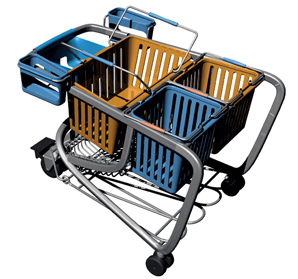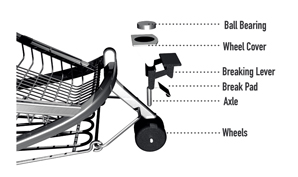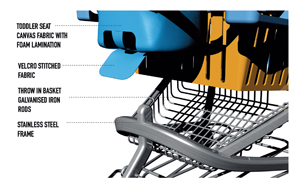Home » Viewpoints » Overhauling The Cart
Overhauling The Cart
By Chanda Kumar | June 23, 2016
The idea was to make a cart which is modular, can be loaded as required and also helps in segregating the products. It had to allow consumers to shop independently and use it to carry when required.
 The modern store environment has been transforming itself over the years, with each of its elements evolving to keep up with the times. However, the humble shopping cart has been hidden under shadows and shunned away to the corner of the store. This caught the eye of Abhishek Karmakar, a final year student at Design For Retail Experience, R&D Campus, NID Bangalore. He chose this as his classroom project and aimed towards improving the shopping cart experience in retail formats like hypermarkets/ supermarkets.
The modern store environment has been transforming itself over the years, with each of its elements evolving to keep up with the times. However, the humble shopping cart has been hidden under shadows and shunned away to the corner of the store. This caught the eye of Abhishek Karmakar, a final year student at Design For Retail Experience, R&D Campus, NID Bangalore. He chose this as his classroom project and aimed towards improving the shopping cart experience in retail formats like hypermarkets/ supermarkets."If you do a little research you will find that the design of shopping carts have not changed from decades except some minor value addition. I think the system would increase the flexibility of the shopping process to a great extent," Abhishek shares.
Problems Identified during field study:
- A considerable number of carts are lying unattended around the corners of the mart.
- The shopping cart was bulky, with a heavy frame
- Lack of adaptability to differently packaged products.
- Lack of system to organise products.
- No breaking system for the trolley, with only a rubber padding to the wheel which clings onto the escalates surface.
- The material used for the toddler seat is inappropriate, unsafe and incorrect ergonomics.
 Design Objective
Design ObjectiveAbhishek was looking to enhance the shopper's experience in choosing products and carrying it till the billing counter. The design brief was written after the general research at Big Bazaar and after identifying areas for improvement.
"In supermarkets and hypermarkets you will often see that there are very narrow aisles where there is hardly space for two people to pass. The cart will definitely help reducing the congestion in those kind of areas. People will also be encouraged to carry baskets to shop as they always have the option to adding it onto a cart. Also it will help people organise their purchase and carry certain products in a right way, for example the soft drinks bottles needed to be carried upright and it shouldn't shake. So the bottle holding baskets in the cart solves the purpose," Abhishek says
Taking the project to the next level, Abhishek had to first analyse the existing cart in terms of the construction, physical dimensions, features, mechanisms etc. After this, the cart frame and the arrangements of the baskets in the cart, as well as, the'Nesting Mechanism' was ideated. "Preliminary sketches of the overall shopping cart with initial ideas of nesting mechanism and toddler seat which were to be further refined."
 Design Innovation
Design InnovationThe idea was to make a cart which is modular, can be loaded as required and also helps in segregating the products. It had to allow consumers to shop independently and use it to carry when required.
Toddler Seat
Is made out of waterproof canvas with foam cushioning. Also, fabric is a better material ergonomically as it will take the shape of the body as a toddler sits on it and safe as no moving parts are involved.
The Baskets
The shape of the baskets were kept unchanged from the existing. The only addition to the basket were the hooks which can nest onto the rods of the cart.
 The Breaking System
The Breaking SystemThe breaking system in the cart allows it to be left at a place while the customer can use the basket to select products and then nest it back to the cart.
Design to Reality
While Abhishek hasn't approached any retailer to convert his design to reality yet, he hopes something will workout before he finishes his masters in NID.
The skeleton of the trolley would be made out of hollow stainless steel pipes which will give it a better structural strength, have lesser joinery and fewer elements which makes it more durable. But, the toddler seat, which will be made out of fabric would need a to be changed from time to time.
"The manufacturing cost of the trolley is expected to be lesser than the current trolley as it uses lesser amount of material and as the basket are not separate elements, they are integrated together. So it automatically cuts down the cost," he explains.
Advertisement
Related Viewpoints
Advertisement









Comments